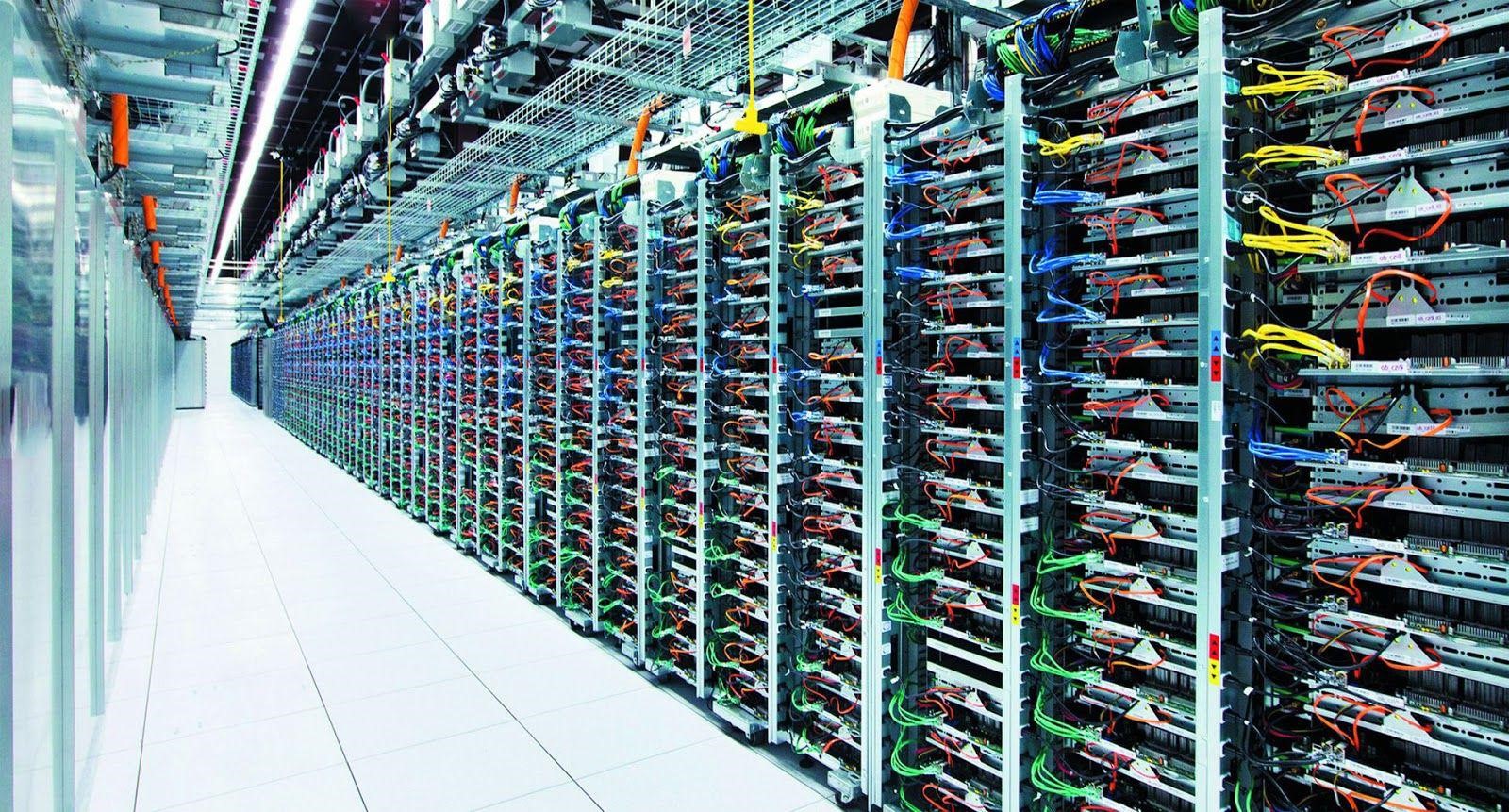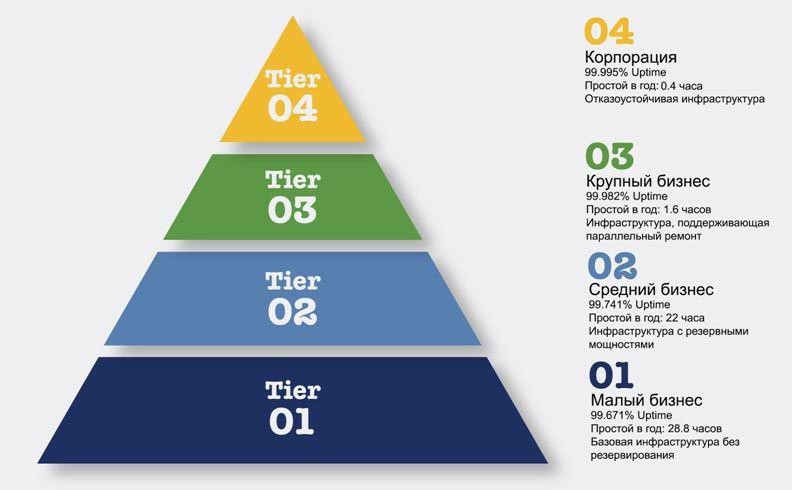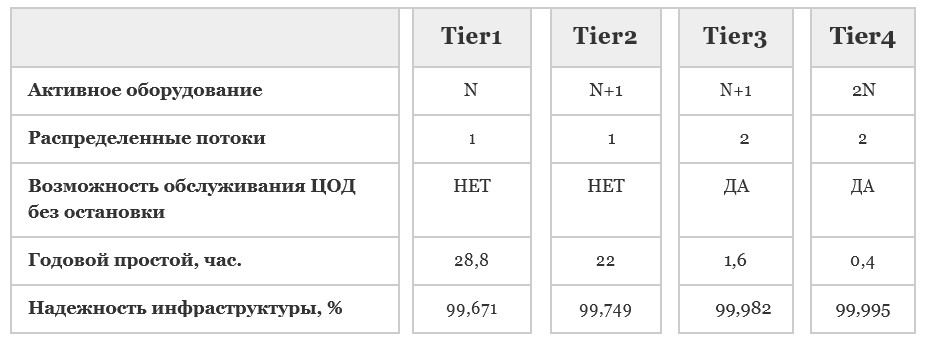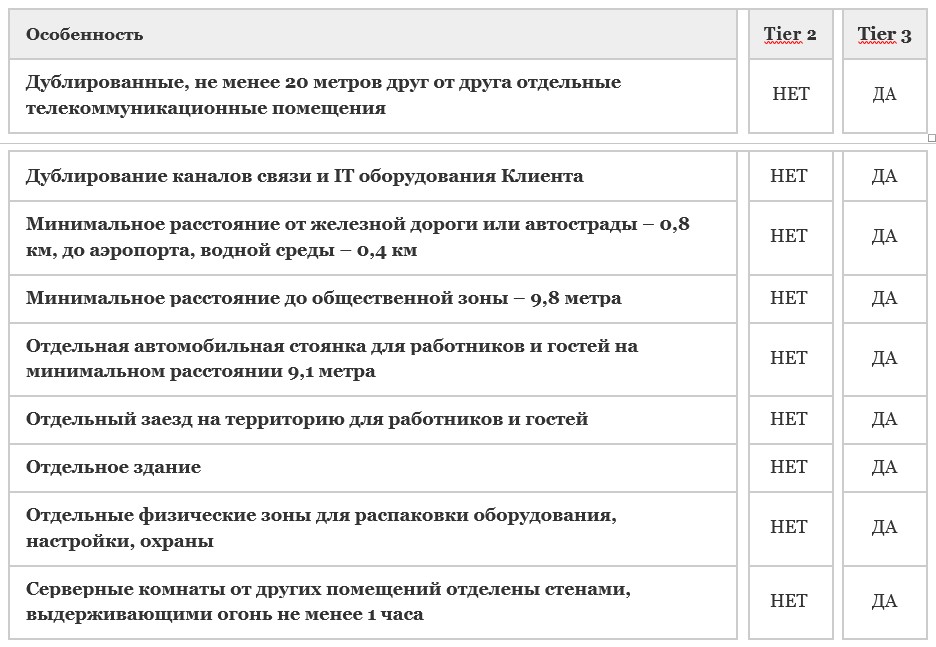Once again about Tier levels
Surely everyone has heard about the data center and Tier , some know that there are some levels of these most Tier and it seems that all this is connected with the servers + is responsible for the stability, security and quality of work of these, but not everything is known in detail, clearly, in detail and everything.

Ie, here, on Habré, there have already been several articles, but they all seem to be not quite complete. As part of this material, I tried to put everything together, systematize and convey everything in accessible language, that is, we briefly go through the definition of data centers, and then dive into Tier , levels, standards and understanding of how it works, which means everything such other.
Let's first define the concept of a data center, which we equate to the concept of data centers, as well as the flow of data (a little further you will understand where the letter “X” came from).
')
Simply put, a data center is nothing more than a specialized building for hosting server and network equipment and then connecting clients to it (not always).
In turn, the servers are engaged in processing, storage and other kinds of data interactions.
Data centers in a complex - and servers in particular - may have different goals, although in most cases it seems that they are a platform for hosting hosting, which is not always true. For the sake of accuracy, it is worth saying that a certain share is occupied by data centers serving mining platforms or simply server parks in them, which are used to calculate critical, from the point of view, often, infrastructure, data.
It is believed that the service and storage centers are mostly focused on corporate clients and even in absolute figures it is close to reality - the data center also serves private clients. The simplest example of the latter can be the placement of your server / servers in a rack for a certain fee, which in essence is a lease of space, or the entire lease of a physical server.
For some reason, the original goal is to reduce the total cost of IT infrastructure for the same business by reducing administrative costs, redistributing workloads, and so on.
In fact, this is not entirely true, since the cost of servicing infrastructure and facilities is included in the cost of renting a unit (and all services) in the data center, as well as almost all other overhead costs that are associated with it. Business does not work at a loss, let it and wins on “consumables” due to the density, infrastructure and wholesale.

The only reasonable and accurate goal for the existence of data and service centers is to ensure stable and uninterrupted operation of all network, server and other equipment located in it. In general, this can be called uptime, about which we will talk further.
Resources and power, scalability and cost, size and people - this is the second. Stability and continuity - the first.
The story, which you undoubtedly know where to find and without the author of the article, began with large computer rooms, designed as far as possible. If you once were in scientific laboratories or objects of strict regime (especially it is a military woman), then you can imagine something like this.
A lot of reasonably laid cables, a special arrangement of the computers themselves, strict instructions, well-thought-out spaces, lighting and much more - all this was originally laid as the basis for future data centers.

Over time, of course, with cheaper equipment and other industry-critical moments, all of this was moved to server (often not very qualified) and so on, and it would seem that soon there would be no need for data centers, but life put everything in its place - the Internet appeared (the growth of data centers grew in 1994–2003 ), high-performance servers / networks / systems and resource-intensive tasks for them and the inhuman need for the above-mentioned stability and uninterrupted operation with which simple server-based with fight, could not cope.
That is, it has become even more vital to not only ensure constant work, but also make it efficient (heat dissipation, power consumption), fast and maintain constant communication with the outside world through backbone and associated channels.
As you already understood, the data center is specialized premises. More precisely, it is a specialized building with premises. More precisely, it is a specialized territory with all the necessary communications + infrastructure + premises, capable not only of storing (storing) all those servers, networks and other equipment, but also ensuring the above stated goals, and especially the already mentioned uptime several times.

Logically, data centers are costly, both at the construction stage and in the maintenance process, but not only (and not so much) financial, as logistics at all levels, and also, naturally, compliance with standards, the severe minimum of which is yourself following list:
The standards themselves are not taken from the ceiling and are associated with the Telecommunications Industry Association , which in turn is engaged in their formation and verification. Such guys who check hotels for five stars, only here are not hotels, but data centers.
DC (data center), if you take it not as a building / room, and the territory and speak generally, consists of:
And now, when we talked with you about the general concept and definition, about representation and standards, correspondences, content, etc., and also a little touched on history, it makes sense to talk about the second part - classification. She's a tier.
Tier , oddly enough, is not an abbreviation and relatively speaking is considered the "level". Generally speaking, it would be worthwhile to call it a standard, according to which a particular data center is classified, but the standard includes substandards, each of which defines ... No, not that.

Rather, it would be appropriate here, as I have already tried to apply the metaphor above, this is an asterisk like hotels. More stars, higher quality in all respects that these stars include. Food, security, cleaning, that's it.
Total data centers (DPCs) are divided into 4 categories - Tier 1, Tier 2, Tier 3 and Tier 4 (Tier 4 is the highest category).
It is considered that the 4th is not in nature, but gradually it begins to certify and the emphasis there is mostly focused on location in space (globally and locally) in order, in particular, to protect against natural disasters. Almost a duplication of nature :)
The centers themselves are divided by size, reliability and purpose:
Now further.
The author warns in advance that he writes the table classification described below as it "remembers".Google suggests that he remembers correctly.
But how much the general compliance parameters have shifted (pay attention to shares) except perhaps Telecommunications Industry Associatio .
So:

Concerning N :
Now to the verbal version.
Let's now see what is what, in fact, in words.
In addition, it is worth knowing that the most popular commercial data centers are Tier 2 and Tier 3 .
Tier 1 does not have the necessary redundancy, and Tier 4 is most often a private ... ahem, data center.
In addition to the level of redundancy and reliability, in fact, Tier 2 and Tier 3 are also distinguished by the presence of their own territory, building, and other features, namely:

It is worth noting that the human network infrastructure begins on the third level of Tier , despite the fact that it is built on the whole quite basic, the reservation of internal and external channels plays a big role.
Particularly wins 3- yka, if the data center of the company that owns them, two or more, and both of them Tier 3 (with different channels outward, but paired between each other).
It should be understood that the certification level Tier is assigned in three stages:
It is necessary to manage to get certification at all stages, especially at the second and last. Otherwise, it turns out that they conceived everything correctly, but everything else is hell and horror - what are the many stars here. As with hotels in general, they drew well, built them moderately, the service is good, but the cook ... Well, you understood.
Thanks for attention :)

Ie, here, on Habré, there have already been several articles, but they all seem to be not quite complete. As part of this material, I tried to put everything together, systematize and convey everything in accessible language, that is, we briefly go through the definition of data centers, and then dive into Tier , levels, standards and understanding of how it works, which means everything such other.
Data center
Introductory and definitions
Let's first define the concept of a data center, which we equate to the concept of data centers, as well as the flow of data (a little further you will understand where the letter “X” came from).
')
Simply put, a data center is nothing more than a specialized building for hosting server and network equipment and then connecting clients to it (not always).
In turn, the servers are engaged in processing, storage and other kinds of data interactions.
Data centers in a complex - and servers in particular - may have different goals, although in most cases it seems that they are a platform for hosting hosting, which is not always true. For the sake of accuracy, it is worth saying that a certain share is occupied by data centers serving mining platforms or simply server parks in them, which are used to calculate critical, from the point of view, often, infrastructure, data.
It is believed that the service and storage centers are mostly focused on corporate clients and even in absolute figures it is close to reality - the data center also serves private clients. The simplest example of the latter can be the placement of your server / servers in a rack for a certain fee, which in essence is a lease of space, or the entire lease of a physical server.
Targets and goals
For some reason, the original goal is to reduce the total cost of IT infrastructure for the same business by reducing administrative costs, redistributing workloads, and so on.
In fact, this is not entirely true, since the cost of servicing infrastructure and facilities is included in the cost of renting a unit (and all services) in the data center, as well as almost all other overhead costs that are associated with it. Business does not work at a loss, let it and wins on “consumables” due to the density, infrastructure and wholesale.

The only reasonable and accurate goal for the existence of data and service centers is to ensure stable and uninterrupted operation of all network, server and other equipment located in it. In general, this can be called uptime, about which we will talk further.
Resources and power, scalability and cost, size and people - this is the second. Stability and continuity - the first.
Some lyrics about ups and downs
The story, which you undoubtedly know where to find and without the author of the article, began with large computer rooms, designed as far as possible. If you once were in scientific laboratories or objects of strict regime (especially it is a military woman), then you can imagine something like this.
A lot of reasonably laid cables, a special arrangement of the computers themselves, strict instructions, well-thought-out spaces, lighting and much more - all this was originally laid as the basis for future data centers.

Over time, of course, with cheaper equipment and other industry-critical moments, all of this was moved to server (often not very qualified) and so on, and it would seem that soon there would be no need for data centers, but life put everything in its place - the Internet appeared (the growth of data centers grew in 1994–2003 ), high-performance servers / networks / systems and resource-intensive tasks for them and the inhuman need for the above-mentioned stability and uninterrupted operation with which simple server-based with fight, could not cope.
The price of a few seconds of idle IT infrastructure began to cost merciless money, therefore demand increased, there was an offer and data centers didn’t just start to grow like a weed, but they began to appear, scale and work more, better and more efficiently.
That is, it has become even more vital to not only ensure constant work, but also make it efficient (heat dissipation, power consumption), fast and maintain constant communication with the outside world through backbone and associated channels.
What is it
As you already understood, the data center is specialized premises. More precisely, it is a specialized building with premises. More precisely, it is a specialized territory with all the necessary communications + infrastructure + premises, capable not only of storing (storing) all those servers, networks and other equipment, but also ensuring the above stated goals, and especially the already mentioned uptime several times.

Logically, data centers are costly, both at the construction stage and in the maintenance process, but not only (and not so much) financial, as logistics at all levels, and also, naturally, compliance with standards, the severe minimum of which is yourself following list:
- TIA-942 - Telecommunications Infrastructure Standard for Data Centers;
- TIA-568-C - Telecommunications cabling standards used throughout nearly all voice, video and data networks;
- TIA-569-B - Commercial Building Standards for Telecommunications Pathways and Spaces;
- TIA-607-B - Commercial grounding - earthing - standards;
- TIA-598-C - Fiber opticcolor-coding);
- TIA-222-G - Structural Standard for Antenna Supporting Structures and Antennas;
- TIA-602-A - Data Transmission Systems and Equipment, which are standardized by the Hayes command set;
- TIA-102 - Land Mobile Communications for Public Safety (APCO / P25).
The standards themselves are not taken from the ceiling and are associated with the Telecommunications Industry Association , which in turn is engaged in their formation and verification. Such guys who check hotels for five stars, only here are not hotels, but data centers.
DC (data center), if you take it not as a building / room, and the territory and speak generally, consists of:
- Information infrastructure - servers, computers, etc;
- Telecommunication infrastructure , - interconnection, networks and communications;
- Engineering infrastructure , - conditionally speaking, everything else, that is, air conditioners, bespereboyniki, fire prevention and so on, that is, “strapping”, which is required for normal functioning.
And now, when we talked with you about the general concept and definition, about representation and standards, correspondences, content, etc., and also a little touched on history, it makes sense to talk about the second part - classification. She's a tier.
Tier
Introductory and definitions
Tier , oddly enough, is not an abbreviation and relatively speaking is considered the "level". Generally speaking, it would be worthwhile to call it a standard, according to which a particular data center is classified, but the standard includes substandards, each of which defines ... No, not that.

Rather, it would be appropriate here, as I have already tried to apply the metaphor above, this is an asterisk like hotels. More stars, higher quality in all respects that these stars include. Food, security, cleaning, that's it.
Total data centers (DPCs) are divided into 4 categories - Tier 1, Tier 2, Tier 3 and Tier 4 (Tier 4 is the highest category).
It is considered that the 4th is not in nature, but gradually it begins to certify and the emphasis there is mostly focused on location in space (globally and locally) in order, in particular, to protect against natural disasters. Almost a duplication of nature :)
The centers themselves are divided by size, reliability and purpose:
- In size - modular, large, small, medium and container. In general, nothing special, except the first and last;
- Reliability - about this below, the levels of reliability are determined by standards, etc;
- According to its intended purpose - for a company or for everyone, depending on the provider or not, and so on.
Now further.
Tabular classification
The author warns in advance that he writes the table classification described below as it "remembers".
But how much the general compliance parameters have shifted (pay attention to shares) except perhaps Telecommunications Industry Associatio .
So:

Concerning N :
- (N) - equipment / maintenance failures lead to the shutdown of the entire DC, often there are no backup channels, power, and so;
- (N + 1) - a bit more redundancy (usually in terms of power), but still everything rises, if that;
- (2N) - decently reserves, one usually at work during technical works, the second one works and vice versa, there is a hot replacement for an engineer, etc.
- (2 (N + 1)) - all backup channels (power, communications, networks, communications, etc.), and the main and additional channels were duplicated (not only the channel, but also the systems), that is, if during those works two duplication systems (main and additional, that is, two more) and in general you can throw a nuclear bomb at DC :)
Now to the verbal version.
Verbal qualification
Let's now see what is what, in fact, in words.
- The first Tier , - the base level, according to the classification relevant in the 1960s and 1970s. In general, this is a small single cozy server with cookies;
- The second is a large server room in normal (false ceilings, air conditioners, UPS, baseboards, and so on) and its performance (or several), where there are additional components (N + 1) of active equipment, racks, and so on;
- The third one is a full-fledged and so far most frequently encountered data center where its territory is used, the building (or several), security, all necessary systems and communications, the distribution of flows of these systems and communications is duplicated, in particular, it concerns cooling pipelines, communication channels in a building food in all its senses and for any occasion;
- Fourth , everything is there, plus multiple duplication of everything, and duplication of duplicates of all this. No matter what anyone says, as mentioned above (sorry for tautology), it is not found in nature in general.
In addition, it is worth knowing that the most popular commercial data centers are Tier 2 and Tier 3 .
Tier 1 does not have the necessary redundancy, and Tier 4 is most often a private ... ahem, data center.
In addition to the level of redundancy and reliability, in fact, Tier 2 and Tier 3 are also distinguished by the presence of their own territory, building, and other features, namely:

It is worth noting that the human network infrastructure begins on the third level of Tier , despite the fact that it is built on the whole quite basic, the reservation of internal and external channels plays a big role.
Particularly wins 3- yka, if the data center of the company that owns them, two or more, and both of them Tier 3 (with different channels outward, but paired between each other).
Afterword
It should be understood that the certification level Tier is assigned in three stages:
- Development of documentation for the construction of the data center;
- Building;
- Service.
It is necessary to manage to get certification at all stages, especially at the second and last. Otherwise, it turns out that they conceived everything correctly, but everything else is hell and horror - what are the many stars here. As with hotels in general, they drew well, built them moderately, the service is good, but the cook ... Well, you understood.
Thanks for attention :)
Source: https://habr.com/ru/post/429238/
All Articles